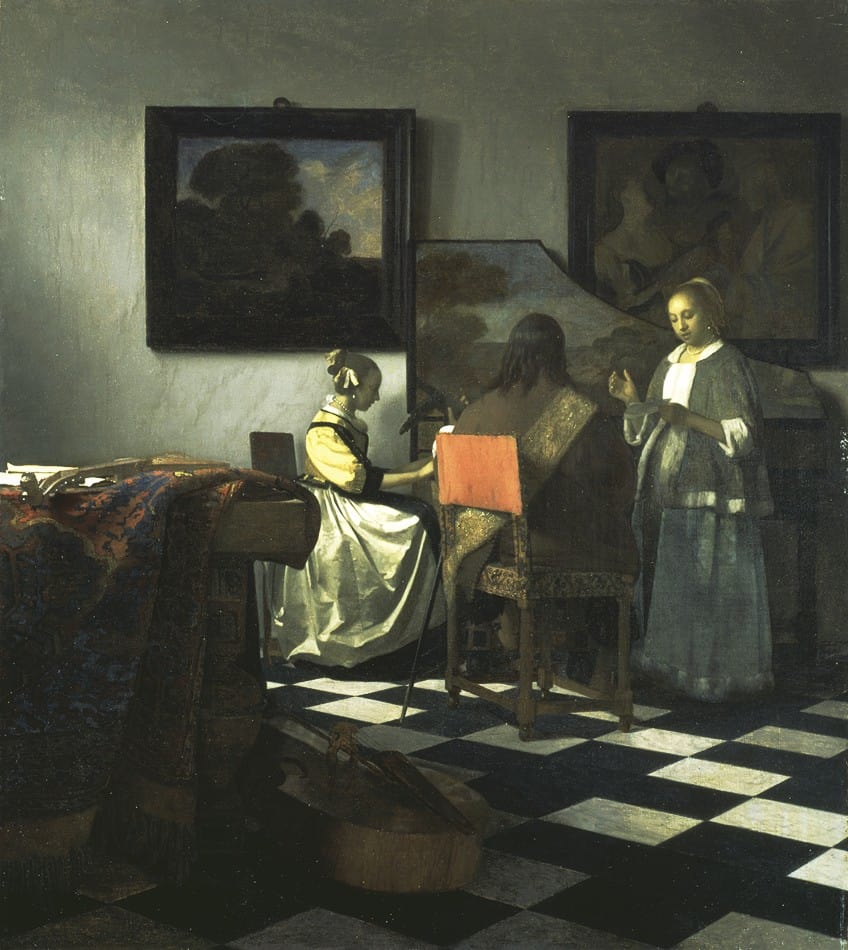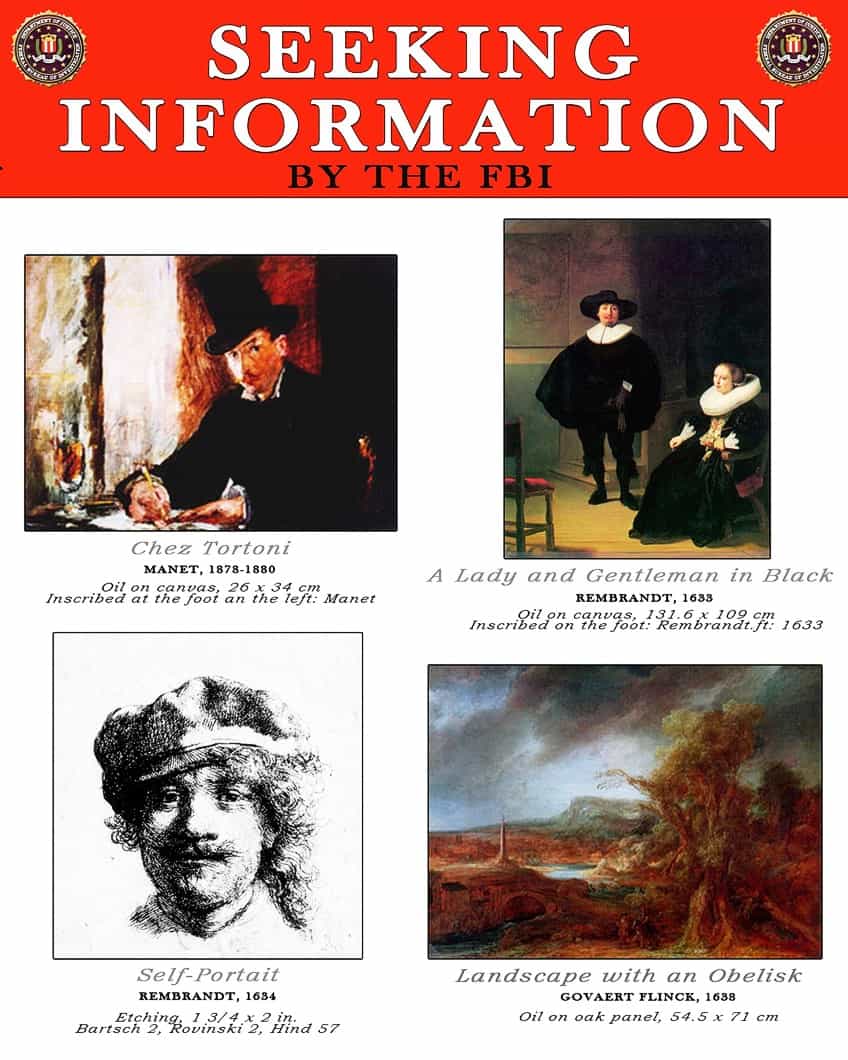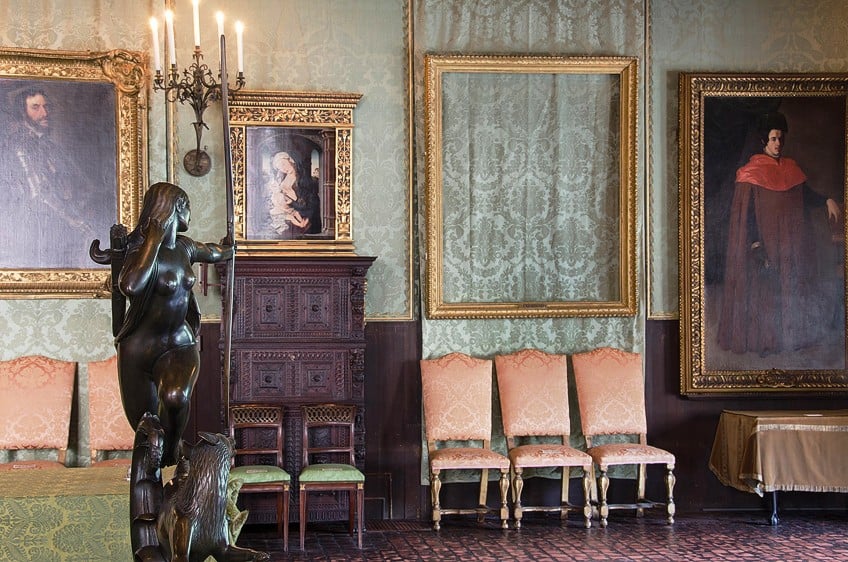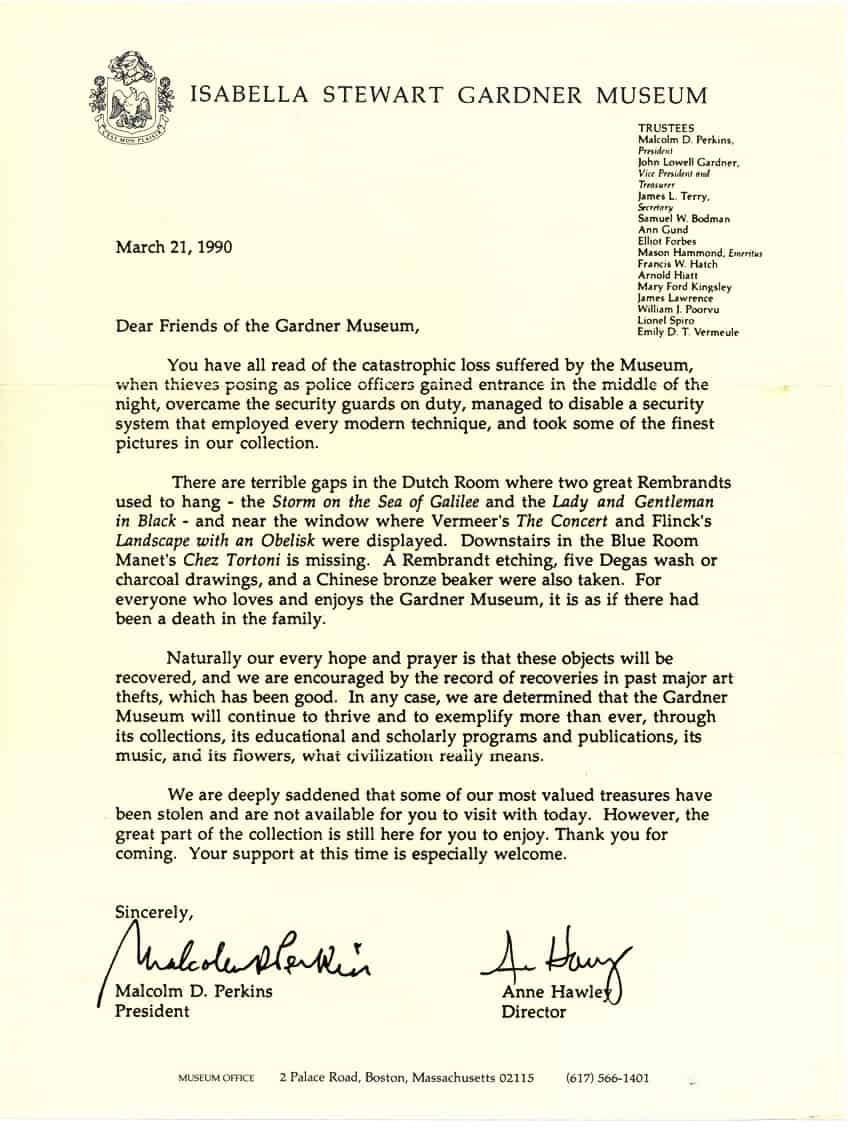Gardner Museum Heist – Learn About the Infamous Art Robbery
It was in the early hours of the 18th of March, 1990, when one of the most audacious museum robberies ever took place. In the infamous Gardner Museum heist, 13 valuable artworks were stolen by two daring individuals. What is particularly strange was that many artworks exhibited at the museum were more highly valued, yet were not removed by the robbers. To discover more about the Isabella Stewart Gardner Museum heist, keep reading below!
Contents
Exploring the Infamous Gardner Museum Heist
The museum was originally built to display the art collection of Isabella Stewart Gardner. It was officially opened to the general public in 1903, and she continued expanding the collection and arranging it until she eventually passed in 1924. The museum’s funding was beginning to run low in the 1980s. It was in a rather bad shape as a result of this financial stress; it needed a climate control system and basic maintenance to the building.
After the FBI identified a robbery planned by Boston criminals in 1982, the museum expended some of its funds on increased security. Among the upgrades were 60 motion detectors and four cameras installed around the perimeter of the museum.

However, no cameras were placed because the board of trustees decided that integrating such equipment into the historic structure would be too expensive. Additional security guards were also employed. Despite these security upgrades, the only means for summoning police to the button was with the press of a single button located at the security desk. Some museums at that time had fail-safe systems that required overnight security to contact the police every hour to confirm that everything was okay. In 1988, an independent security expert assessed the museum’s operations and reported that they were on the same level as most other institutions, but that they could perhaps still be improved.
The board of trustees declined to approve these security upgrades due to the museum’s budgetary constraints, as well as Isabella Stewart Gardner’s views against any substantial modifications to her museum.
The Night of the Gardner Museum Heist
Several St. Patrick’s Day guests departing a celebration near the museum saw the burglars at approximately 12:30 a.m. The two males were dressed as policemen and sat in a hatchback car on Palace Road, around 30 meters from the side door, and eyewitnesses mistook them for actual police officers. Rick Abath and Randy Hestand were the security on duty that night; Rick Abath had been working there for a while already, while Hestand was working his first night shift at the museum.
According to the security protocols, one person was meant to patrol the halls with a flashlight and two-way radio, while the other remained at the security desk.

Abath was the first to go on patrol, and while he was there, fire alarms went off in several sections of the building, but he couldn’t find any smoke or flames. He then returned to the security desk, where the fire alarm panel revealed that there was smoke in several rooms. He thought it was most likely just a fault and turned off the panel. He returned to patrolling and, before finishing his round, stopped for a brief moment at the museum’s side door, quickly opening and closing it. He didn’t tell the other security guard why he was doing it.
Abath finished his patrol and arrived back at the security desk at about 1:00 a.m. when Hestand started his rounds.
Subduing the Guards
The criminals drove up to the museum’s side entrance, proceeded to park, and walked straight up to the side door at around 1:20 a.m. They pressed the doorbell, which allowed them to communicate with Abath through the intercom system. They informed the guard that they were policemen investigating a reported disturbance and that they needed to be let inside. They were wearing what seemed to be police uniforms, and Abath could observe them through closed-circuit television. He was unaware of any disruption but speculated that because it was St. Patrick’s Day, a partygoer may have gone over the fence and been observed and reported.
At 1:24 a.m., Abath allowed the men in. The burglars were let into a secured foyer that connected the side door to the building.
They confronted Abath at his desk and asked if there were any more people in the building and if they could come down; he radioed Hestand to come back to the desk. It was around this moment that Abath observed that the one officer’s mustache seemed to be a fake. The other person then told Abath that he looked familiar, that they could possibly have an outstanding warrant for his arrest, and that he should step out from behind the desk and produce some form of identification. Following the officer’s orders, he nodded and moved away from the desk, where the sole panic button to alert law enforcement was located. He was then pushed against a wall, his legs splayed, and he was handcuffed.

It was around this time that Hestand entered the room, and the one thief swung him around and tied him. After handcuffing both security guards, the robbers stated their genuine intentions to loot the museum and urged the security personnel not to cause them any issues. The robbers stretched duct tape around their heads and then led them into the basement, chained to a workbench and steam pipe, without even asking for directions on how to get there.
They inspected the guards’ wallets and said that they now knew where they resided, that they were not to tell investigators anything, and that they would receive a reward in roughly a year.
Looting of the Paintings
Infrared motion detectors tracked the burglars’ activities through the building. The first room they visited, the Dutch Room, did not have any movements registered until 1:48 a.m. This was 13 minutes after they had finished restraining the security guards, maybe to ensure that no police were notified. As they approached the artworks in the Dutch Room, a mechanism that would typically trip when a customer got too close to a picture began beeping, which the robbers then destroyed.
They tossed A Woman and a Gentleman in Black (1633) and The Storm on the Sea of Galilee (1633), both by Rembrandt, on the museum’s marble floor, shattering their glass frames. They then proceeded to slice the canvases off their stretchers using a blade. A big Rembrandt self-portrait art piece was also taken from the wall but was left resting against a cabinet.
Authorities suspect they considered it too big to move, maybe because it was created on wood rather than a more resilient yet lighter canvas like the others. Instead, the burglars stole a small self-portrait etching by Rembrandt displayed beneath the bigger artwork. They also removed The Concert (1664) by Johannes Vermeer and Landscape with Obelisk (1638) by Govert Flinck from their frames. The last object removed from the room was an old Chinese “gu”. Just after 1:50 a.m., one burglar kept on working in the Dutch Room, and the other burglar approached the Short Gallery, a small passageway located at the opposite end of the second floor. Soon after, the other thief arrived. They started to remove screws from a frame hanging a Napoleonic flag in this chamber, most likely in an attempt to take the flag.

They seemed to have given up halfway through since not all of the screws were taken out, and they subsequently took only the unprotected eagle finial on top of the flagpole. In addition to that, they also stole five Degas drawings from the room. Chez Tortoni (1875) by Édouard Manet from the Blue Room on the first level was the final artwork taken. The motion detectors at the museum did not register any movement in this during the robbers’ visit. The only movement in the chamber that night was that of Abath, who had gone through the gallery twice earlier on his patrol. The burglars checked in on the security guards one more time before leaving, asking whether they were comfortable.
They then went to the security director’s office and stole the videotape cassettes that had been recorded on the closed-circuit equipment as well as the print-outs from the motion detecting systems.
Yet, the movement data was also recorded on a hard disk, which remained unmodified. The criminals then proceeded to remove the artwork from the museum. When the next security shift came later in the morning, they sensed something was wrong when they couldn’t establish communication with anybody inside to be admitted in. They phoned the security director, who entered the museum with his keys and discovered no one at the security desk, so he notified law enforcement. The security guards were still bound in the basement when the police subsequently searched the museum.
Artworks Stolen During the Gardner Museum Heist
In total, 13 very valuable works of art were taken. The FBI assessed the total value at $200 million in 1990, then increased it to $500 million in the year 2000. Other art dealers estimated the find to be worth $600 million in the late 2000s. The Gardner Museum heist is regarded as the most valuable museum robbery ever.
The most expensive paintings were removed from the Dutch Room. The Concert by Vermeer, one of only 34 paintings credited to him, was among them.
This painting alone is worth half of the stolen collection’s estimated value of $250 million in 2015. According to researchers, it might be the most expensive stolen object on the planet. The final object taken from the Dutch Room was a 25-centimeter-tall bronze gu (ancient ritual vessel). The beaker, which was customarily used to serve wine in ancient China, is among the museum’s oldest pieces, dating from the Shang Dynasty in the 12th century BCE. It is thought to be worth a few thousand dollars. Experts were quite perplexed by the odd combination of stolen objects.

While some of the artworks were significant, the robbers walked by other very valuable paintings by Botticelli, Raphael, and Michelangelo and left them alone, preferring to remove comparatively insignificant objects like the ancient Chinese gu. The robbers never made it to the third story, where The Rape of Europa by Titian, one of the city’s most valued artworks, was displayed. Investigators think the burglars were not specialists commissioned to take specific paintings based on their choice of artworks and their careless handling of the artworks.
Because Gardner’s will stated that nothing in her collection should be relocated, the empty frames for the taken artworks are still hanging in their original locations around the institution as placeholders for their possible return.
People of Interest in the Gardner Museum Heist
The F.B.I. took immediate charge of the investigation since the artworks were anticipated to cross state boundaries. The case has been described as unusual by investigators because of the absence of solid physical evidence. The burglars left no footsteps or hair, and it is unclear if the fingerprints found at the site were left by the burglars or museum staff. Due to his questionable actions on the night of the Gardner Museum heist, Rick Abath, the security guard, was scrutinized early on in the investigation.
While on patrol, Abath momentarily opened and closed a side door, which some people believe was a signal to the criminals parked outside. According to Abath, he did this regularly to guarantee the door was secured.
One of Abath’s coworkers told the media that if Abath had opened the door regularly, as he claims, supervisors would have noticed it on digital printouts and stopped it. Abath maintains that he is innocent, and the FBI agent in charge of the inquiry in its early stages determined that the security guards were too inept and naive to commit the Gardner Museum heist. Another suspect was Whitey Bulger, who led the Winter Hill Gang and was one of Boston’s most influential criminal lords at the time.

He said he did not orchestrate the robbery and had even sent his operatives out to discover the perpetrator because the incident occurred on his “turf” and he deserved to be given tribute. The F.B.I. believed that Bulger’s close links to the Boston Police Department may explain how the criminals obtained authentic police uniforms, or that perhaps actual officers were recruited to pull off the Gardner Museum heist.
Brian McDevitt, a conman from Boston who attempted to steal The Hyde Collection in 1981, was another suspect.
He disguised himself as a FedEx driver, armed himself with cuffs and duct tape, and intended to steal a Rembrandt painting. He was also a recognized flag collector, and save for his receding red hair, he suited the profile of the taller thief. The FBI was intrigued by the Gardner case comparisons and interrogated him in late 1990. McDevitt denied any participation and declined to submit to a polygraph examination. His fingerprints did not correspond to any of those found at the crime site, according to the FBI. McDevitt eventually relocated to Hollywood and conned his way into writing for television and cinema.

In March 2013, the F.B.I. claimed substantial progress in its investigations. They reported identifying the perpetrators with a considerable degree of confidence, believing they were part of a criminal group located in New England and the mid-Atlantic. They were also “certain” that the artworks were transferred to Philadelphia and Connecticut in the years after the crime, including an unsuccessful sale in Philadelphia in 2002. Their understanding of what transpired after that is scant, therefore they asked for the public’s assistance in locating and returning the artworks. Both suspects were declared dead by the F.B.I. in 2015. Although the F.BI. would not officially identify any people, sources familiar with the inquiry claimed they were members of a Dorchester gang.
With that, we conclude our examination of the peculiar Gardner Museum heist. Although so many years have passed, it seems that there are still no definitive answers regarding this case. And, if the suspects have passed away as the F.B.I. believe, then perhaps the truth went to the graves along with the robbers.
Frequently Asked Questions
What Was the Gardner Museum Heist?
It was the robbery of the Isabella Stewart Gardner Museum, which occurred in 1990. During the heist, two robbers pretending to be policemen responding to a call of disturbance were let in by security, who were subsequently tied up and cuffed in the basement. The robbers then proceeded to steal 13 valuable artworks over a period of around 80 minutes before leaving the premises, never to be seen or heard from again.
Why Is the Gardner Museum Heist Regarded As Odd?
There were certain occurrences during the heist that struck investigators as odd. One was the suspicious behavior of one of the security personnel, who opened and closed a side door for no apparent reason. Another peculiar thing was that many of the most valuable artworks in the museum remained untouched, while other relatively less valuable works were taken.
Liam Davis is an experienced art historian with demonstrated experience in the industry. After graduating from the Academy of Art History with a bachelor’s degree, Liam worked for many years as a copywriter for various art magazines and online art galleries. He also worked as an art curator for an art gallery in Illinois before working now as editor-in-chief for artfilemagazine.com. Liam’s passion is, aside from sculptures from the Roman and Greek periods, cave paintings, and neolithic art.
Learn more about Liam Davis and about us.
Cite this Article
Liam, Davis, “Gardner Museum Heist – Learn About the Infamous Art Robbery.” artfilemagazine – Your Online Art Source. May 4, 2023. URL: https://artfilemagazine.com/gardner-museum-heist/
Davis, L. (2023, 4 May). Gardner Museum Heist – Learn About the Infamous Art Robbery. artfilemagazine – Your Online Art Source. https://artfilemagazine.com/gardner-museum-heist/
Davis, Liam. “Gardner Museum Heist – Learn About the Infamous Art Robbery.” artfilemagazine – Your Online Art Source, May 4, 2023. https://artfilemagazine.com/gardner-museum-heist/.



